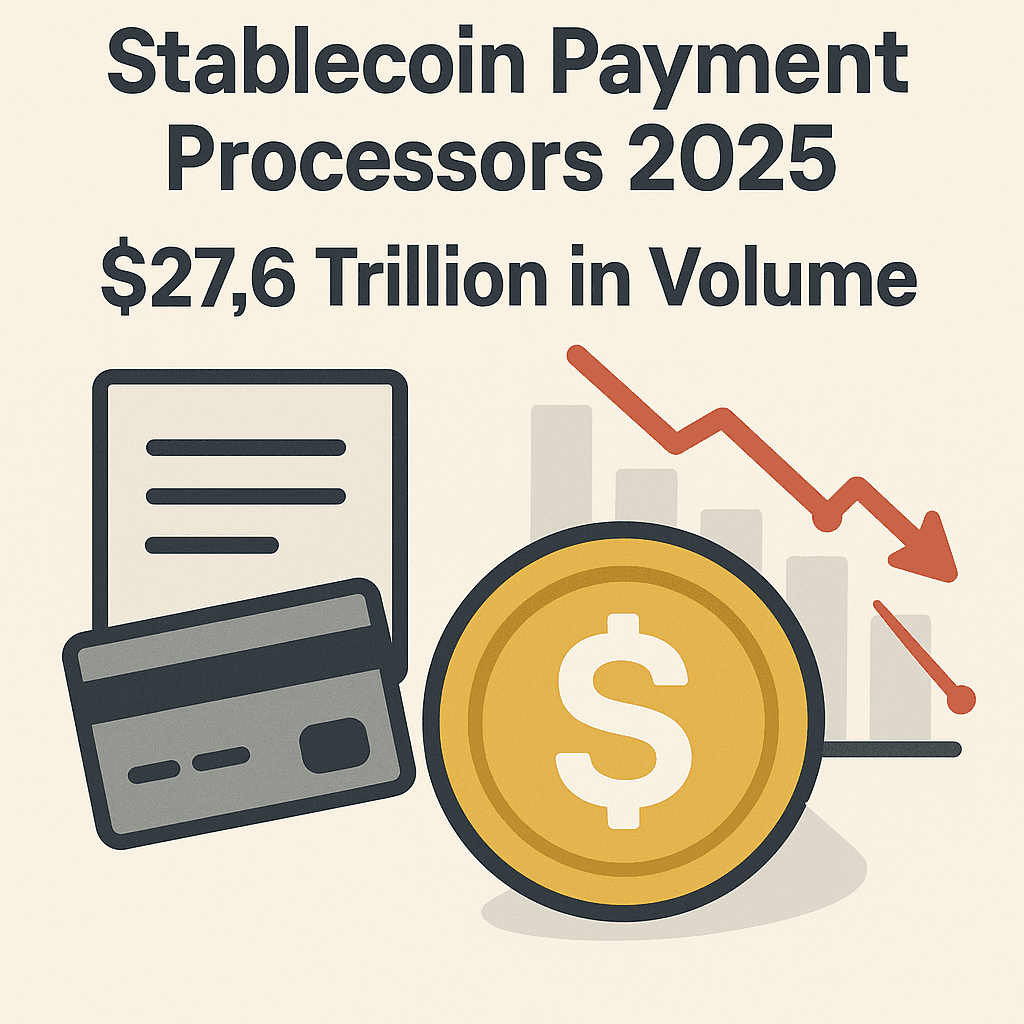The stablecoin payment processing industry just achieved something remarkable: $27.6 trillion in transaction volume during 2024, officially surpassing the combined transaction volume of Visa and Mastercard by 7.68%. Yet despite this massive validation, nearly every major crypto payment processor is optimizing for the wrong customerand missing the biggest opportunity in crypto treasury management since DeFi launched.
What Are Stablecoin Payment Processors Actually Building?
Walk through today's crypto payment processing landscape and you'll see a striking pattern. Companies like Bridge, Conduit, Mural Pay, and dozens of others are all building variations of the same product: faster fiat transport systems.
Their value proposition sounds familiar:
"Move your dollars faster than banks"
"Cheaper cross-border payments"
"Instant settlement vs traditional wires"
The Current Stablecoin Payment Processing Model
These stablecoin payment processors follow a predictable playbook:
Accept USDC, USDT payments to bypass banking delays
Immediately convert to fiat currency
Deposit into traditional bank accounts
Charge fees on volume or FX spreads
This approach treats blockchain infrastructure as a commodity transport layer—like using the internet for faster fax machines. The problem? They're solving for customers who want to exit crypto as quickly as possible.
The Crypto Treasury Management Gap Everyone's Missing
While payment processors race to build better "crypto-to-fiat" pipes, a massive opportunity sits completely unaddressed: businesses that want to stay on-chain.
Consider the numbers:
28.5M unique stablecoin users sent over 600M transactions last month
121.67 million addresses now hold stablecoins
The number of freelancers globally paid in stablecoins increased by 39% in 2024
These users already understand stablecoins. They don't need convincing to adopt crypto—they need better crypto-native financial infrastructure.
High Yield Business Bank Accounts: The DeFi Advantage
When both parties in a transaction are comfortable with stablecoins, entirely new capabilities become possible:
Traditional vs Crypto-Native Business Banking
Traditional Bank Accounts typically offer minimal yield on deposits, usually ranging from 0.01% to 0.5% APY. International settlements take T+2 processing time, payment programmability is non-existent, and reversibility requires complex chargeback processes that can take 30+ days. Geographic restrictions limit global access, and compliance relies on manual reporting systems.
High Yield Crypto Business Accounts powered by DeFi lending protocols offer 4-8% APY on stablecoin deposits. Settlement happens instantly, 24/7, with smart contract automation enabling programmable payment logic. Reversibility works through instant escrow and release mechanisms, global access is borderless, and compliance features on-chain audit trails for transparent reporting.
Programmable Yield: The Revenue Model Traditional Processors Can't Match
Here's where crypto treasury management gets interesting. Instead of charging fees on transactions, programmable yield systems can make every payment profitable:
How Instant Yield Changes Business Banking
Traditional Model: Company receives $100k payment → sits in 0.01% checking account → earns $10/year
Programmable Yield Model: Company receives $100k USDC → automatically deploys to DeFi lending → earns $4,000-8,000/year → can access instantly when needed
This isn't theoretical. Platforms offering stablecoin business accounts with integrated DeFi yield are already generating substantial returns for corporate treasuries.
Crypto Point of Sale Systems: Where Programmable Payments Shine
The retail application shows how powerful this becomes. A crypto point of sale system built for programmable money can:
Accept any token (including meme coins)
Automatically swap to preferred stablecoin
Deploy funds to yield-bearing protocols in the same transaction
Enable dynamic discounting based on projected yield
Real-World Use Case: Coffee Shop Economics
Traditional POS: $5 coffee → 2.9% credit card fee → $4.85 to merchant → 0% yield on cash Crypto POS: $5 USDC → 0% processing fee → $5 to merchant → immediate 6% APY → $0.30 additional annual revenue per transaction
Scale this across thousands of transactions and stablecoin payment processing becomes a profit center, not a cost center.
Corporate Stablecoins: The $14 Billion Validation
The market is about to get much bigger. Amazon and Walmart are exploring issuing their own stablecoins, potentially shifting billions away from traditional payment networks.
The economics are compelling:
Amazon: ~$638 billion annual revenue
Walmart: ~$100+ billion in e-commerce sales
Combined card processing fees: Estimated $14+ billion annually
Why Corporate Stablecoins Need Programmable Infrastructure
Corporate stablecoins solve the "transport" problem but miss the bigger opportunity:
What Corporate Stablecoins Can Do:
Issue compliant digital currency
Reduce interchange fees to near-zero
Settle payments in seconds vs days
What They Can't Do (Without Programmable Infrastructure):
Generate yield on corporate treasury balances
Create conditional payment logic for supply chains
Enable automated B2B workflow integration
Build escrow and multi-signature governance
This infrastructure gap creates massive partnership opportunities.
The GENIUS Act: Regulatory Clarity for Stablecoin Business Banking
The Senate passed the GENIUS Act 68-30, and the House approved it 308-122, creating the first comprehensive stablecoin regulatory framework.
Key Implications for Crypto Treasury Management:
Banks Will Be Allowed To:
Issue compliant stablecoins
Provide custody and basic transfer services
Integrate with traditional banking infrastructure
Banks Will Be Prohibited From:
Offering yield directly on stablecoin balances
Creating programmable payment products
Engaging in DeFi strategies for clients
This creates natural specialization opportunities: banks handle compliance, technology providers build the programmable layer.
DeFi Business Banking: The Technical Architecture
Modern DeFi business banking platforms are built on several key components:
1. Smart Account Architecture
Non-custodial business accounts
Multi-signature governance
Programmable spending rules
Automated yield optimization
2. Yield Integration Infrastructure
Direct integration with audited DeFi protocols
Real-time yield optimization across multiple strategies
Principal/yield segregation for accounting
Instant liquidity without breaking yield generation
3. Programmable Payment Logic
Escrow-based transfers with yield continuity
Conditional releases based on milestones
Multi-party approval workflows
Time-locked payments with revenue sharing
Stablecoin Payment Processing: Competitive Analysis
Let's examine how current providers approach the market and where opportunities exist:
Bridge (Acquired by Stripe for $1B) focuses primarily on fiat on/off ramps and basic stablecoin infrastructure. Their business model relies on transaction fees plus FX spreads, but they don't offer yield generation capabilities or advanced programmability features.
Conduit (Recently raised $36M Series A) specializes in cross-border B2B payments via stablecoins. They earn revenue through per-transaction fees and currency conversion margins, but their system immediately converts to fiat, missing treasury optimization opportunities.
Mural Pay targets Latin America contractor payments with a zero-fee model, generating revenue from FX conversion. However, they're limited to payroll use cases and don't offer yield features for business treasury management.
The pattern across all major providers is clear: they optimize for speed and cost reduction but none capture the yield opportunity that crypto-native businesses actually want.
Best Stablecoin Payment Processors for Crypto-Native Businesses
For businesses ready to embrace programmable money, evaluation criteria should include:
Essential Features for Crypto Treasury Management:
Instant yield deployment on all incoming payments
Programmable escrow with conditional releases
Multi-signature treasury controls
Real-time yield optimization across DeFi protocols
On-chain compliance and audit trails
Reversible transfers without traditional banking delays
Questions to Ask Potential Providers:
Can funds earn yield while in escrow?
Do you offer programmable payment conditions?
How quickly can I access funds without breaking yield?
What DeFi protocols do you integrate with?
Can I set automated treasury management rules?
The Future of Crypto Payment Processing
The industry is splitting into two distinct paths:
Path 1: Commodity Rails (Current Majority)
Competing on basis points and speed
Racing toward zero margins
Building for crypto-to-fiat customers
Limited to transport functionality
Path 2: Programmable Infrastructure (Massive Opportunity)
Value-based pricing models
Network effect moats
Building for crypto-native customers
Full financial workflow automation
86% of payment providers say their infrastructure can handle stablecoin flows, and 85% see regulations as enablers rather than barriers. The infrastructure is ready. The regulatory framework is clear.
How RebelFi Approaches Programmable Stablecoin Infrastructure
At RebelFi, we're building for Path 2: the crypto-native customer who wants programmable money, not just faster fiat transport.
Our approach differs fundamentally:
Instant Yield on Every Transaction
Payments deploy to DeFi lending protocols in the same transaction they're received
Zero idle time between receipt and yield generation
Continue earning while funds are in escrow or pending approval
Pull-Based Payment Architecture
Payers authorize secure transfers that recipients claim
Funds continue earning yield until collected
Built-in reversibility without banking intermediaries
Perfect for payroll, subscriptions, and recurring payments
Programmable Business Logic
Conditional releases based on milestones, time, or external data
Multi-signature treasury management with delegated authorities
Automated yield splitting between principal and returns
FBO-style accounts for customer loyalty and prepaid balances
This isn't just a faster payment rail—it's programmable financial infrastructure that makes every business relationship more valuable.
Frequently Asked Questions: Stablecoin Business Banking
What are the best stablecoins for business treasury management?
USDC and USDT dominate with over 90% market share. USDC offers stronger regulatory compliance, while USDT provides broader global liquidity. PYUSD is emerging as a PayPal-backed alternative.
How much yield can businesses earn on stablecoin deposits?
Current DeFi lending rates for USDC range from 4-8% APY depending on market conditions and protocol selection. This significantly exceeds traditional business banking rates of 0.01-0.5%.
Are stablecoin business accounts FDIC insured?
No, but many use collateralized lending protocols that are over-collateralized and audited. Some providers offer insurance through specialized crypto insurers.
How do taxes work for stablecoin business income?
Yield from DeFi lending is generally treated as business income. Consult a crypto-specialized accountant for specific guidance based on your jurisdiction.
Can I integrate stablecoin payments with existing accounting software?
Yes, leading platforms offer API integrations with QuickBooks, Xero, and other accounting systems to automatically sync transactions and yield income.
Conclusion: The $27.6 Trillion Opportunity
The stablecoin payment processing industry has proven massive market demand. $27.6 trillion in annual volume validates that businesses want better financial infrastructure.
But the current generation of providers is optimizing for yesterday's customer: those who want to get out of crypto as quickly as possible.
The real opportunity lies in serving tomorrow's customer: crypto-native businesses that recognize programmable money as a fundamental upgrade to how financial relationships work.
The companies that choose to build programmable infrastructure won't just capture market share, they'll create entirely new markets that generate value for both parties in every transaction.
The infrastructure is ready. The regulations are clear. Corporate adoption is accelerating.
The only question left: Are you building for the customer who sees stablecoins as better fiat transport, or the customer who recognizes stablecoins enable entirely new financial systems?



